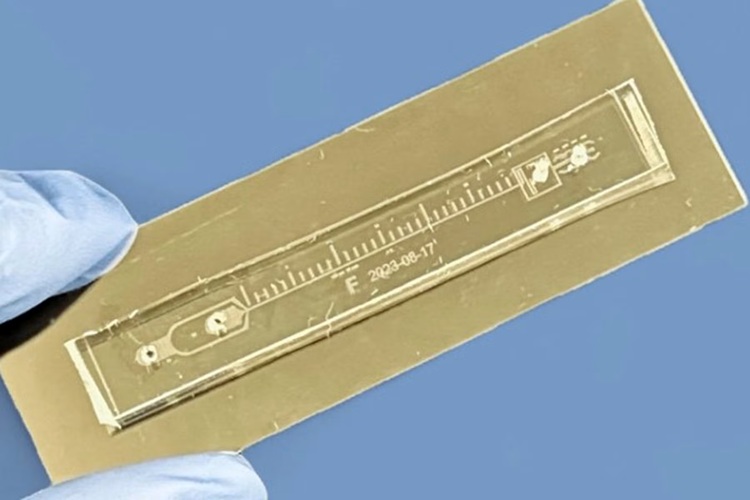State-Of-The Art Techniques to Investigate Immune Response in Deadly Strep A Infections
|
By LabMedica International staff writers Posted on 23 Feb 2024 |

Annually, a staggering half a million people, including numerous children and young individuals, succumb to serious infections caused by the group A streptococcal (Strep A) bacteria globally. Strep A is highly transmissible and spreads from person to person mostly via the respiratory route from sore throats. Strep A is typically known for causing sore throats and skin infections in younger children. In rare cases, it can lead to more severe conditions like sepsis and toxic shock if the bacteria invade the bloodstream or tissue. While adults are often immune to Strep A sore throats and skin infections, both adults and children are very susceptible to the invasive form of the infection. A particularly alarming consequence of repeated Strep A infections is the autoimmune-induced damage to heart valves, termed rheumatic heart disease (RHD). RHD affects approximately 50 million people worldwide, predominantly in middle- and low-income countries. Currently, there is no vaccine available for Strep A. The development of immunity to Strep A over time, including the identification of specific bacterial antigens crucial for targeting by the immune system or future vaccines, remains poorly understood. Additionally, the distinction between detrimental immune overreactions to Strep A, leading to RHD, and the desirable protective immunity is not clearly defined.
In response to this global health challenge, an international collaboration of scientists has established a comprehensive network to investigate the bacterial causes of sepsis and heart damage caused by Strep A. The iSpy Network (immunity to Streptococcus pyogenes), led by Imperial College London (London, UK), along with the University of California San Diego (La Jolla, CA, USA), unites 28 researchers from 11 countries. This diverse group of experts in immunology, infectious disease, epidemiology, vaccinology, and experimental medicine will engage in a five-year project. Their goal is to utilize a broad spectrum of advanced techniques to delve into Strep A immunity with unprecedented detail, ultimately contributing significantly to reducing the global impact of Strep A.
The iSpy-LIFE sub-network aims to uncover how effective immunity to Strep A develops in children, following natural infection over time. This research, involving young children, school-age pupils, and adults, may provide insights into genuine immunity against Strep A and guide the development of a vaccine that mimics and accelerates this immunity in children. Additionally, the iSpy-EXPLORE sub-network is set to explore the nature of protective immune responses in experimental models exposed to promising Strep A vaccine candidates. It will also assess human immune responses in healthy volunteers experimentally exposed to Strep A infections. Collectively, these efforts are poised to enhance understanding of both beneficial and detrimental immunity to Strep A, paving the way for a future vaccine that could protect against strep throat, invasive infections, and RHD.
“The RHD patients we see in LMICs generally present with advanced disease and complications such as heart failure,” said Professor Liesl Zuhlke, a pediatric cardiologist at The University of Cape Town and iSpy team member. “Many require cardiac surgery or percutaneous intervention which are often not available, resulting in significant mortality and morbidity and incurring huge out-of-pocket costs to families and communities. We desperately need data on transitions between the various forms of Strep A diseases and how we can intervene to prevent these manifestations.”
Related Links:
Imperial College London
University of California San Diego
Latest Immunology News
- Chip Captures Cancer Cells from Blood to Help Select Right Breast Cancer Treatment
- Blood-Based Liquid Biopsy Model Analyzes Immunotherapy Effectiveness
- Signature Genes Predict T-Cell Expansion in Cancer Immunotherapy
- Molecular Microscope Diagnostic System Assesses Lung Transplant Rejection
- Blood Test Tracks Treatment Resistance in High-Grade Serous Ovarian Cancer
- Luminescent Probe Measures Immune Cell Activity in Real Time
- Blood-Based Immune Cell Signatures Could Guide Treatment Decisions for Critically Ill Patients
- Novel Tool Predicts Most Effective Multiple Sclerosis Medication for Patients
- Companion Diagnostic Test for CRC Patients Identifies Eligible Treatment Population
- Novel Tool Uses Deep Learning for Precision Cancer Therapy
- Companion Diagnostic Test Identifies HER2-Ultralow Breast Cancer and Biliary Tract Cancer Patients
- Novel Multiplex Assay Supports Diagnosis of Autoimmune Vasculitis
- Blood Test Predicts Immunotherapy Efficacy in Triple-Negative Breast Cancer
- Simple Genetic Testing Could Predict Treatment Success in Multiple Sclerosis Patients
- Novel Gene Signature Predicts Immunotherapy Response in Advanced Kidney Cancers
- New Technology Deciphers Immune Cell Communication to Predict Immunotherapy Response
Channels
Clinical Chemistry
view channel
Chemical Imaging Probe Could Track and Treat Prostate Cancer
Prostate cancer remains a leading cause of illness and death among men, with many patients eventually developing resistance to standard hormone-blocking therapies. These drugs often lose effectiveness... Read more
Mismatch Between Two Common Kidney Function Tests Indicates Serious Health Problems
Creatinine has long been the standard for measuring kidney filtration, while cystatin C — a protein produced by all human cells — has been recommended as a complementary marker because it is influenced... Read moreMolecular Diagnostics
view channel
New Genetic Test Enables Faster Diagnosis of Rare Diseases
Rare disease diagnosis often involves a long and uncertain search for the underlying genetic cause. Traditional testing requires multiple separate analyses, although many patients remain without answers.... Read more
Urine Test Detects Inherited Neuropathy Missed by Genetic Screening
Sorbitol dehydrogenase (SORD)-related neuropathy is one of the most common inherited nerve disorders, yet diagnosis often lags because current genetic screens frequently miss the causal gene.... Read moreHematology
view channel
Platelet Activity Blood Test in Middle Age Could Identify Early Alzheimer’s Risk
Early detection of Alzheimer’s disease remains one of the biggest unmet needs in neurology, particularly because the biological changes underlying the disorder begin decades before memory symptoms appear.... Read more
Microvesicles Measurement Could Detect Vascular Injury in Sickle Cell Disease Patients
Assessing disease severity in sickle cell disease (SCD) remains challenging, especially when trying to predict hemolysis, vascular injury, and risk of complications such as vaso-occlusive crises.... Read more
ADLM’s New Coagulation Testing Guidance to Improve Care for Patients on Blood Thinners
Direct oral anticoagulants (DOACs) are one of the most common types of blood thinners. Patients take them to prevent a host of complications that could arise from blood clotting, including stroke, deep... Read moreMicrobiology
view channel
Rapid Assay Identifies Bloodstream Infection Pathogens Directly from Patient Samples
Bloodstream infections in sepsis progress quickly and demand rapid, precise diagnosis. Current blood-culture methods often take one to five days to identify the pathogen, leaving clinicians to treat blindly... Read more
Blood-Based Molecular Signatures to Enable Rapid EPTB Diagnosis
Extrapulmonary tuberculosis (EPTB) remains difficult to diagnose and treat because it spreads beyond the lungs and lacks easily accessible biomarkers. Despite TB infecting 10 million people yearly, the... Read more
15-Minute Blood Test Diagnoses Life-Threatening Infections in Children
Distinguishing minor childhood illnesses from potentially life-threatening infections such as sepsis or meningitis remains a major challenge in emergency care. Traditional tests can take hours, leaving... Read more
High-Throughput Enteric Panels Detect Multiple GI Bacterial Infections from Single Stool Swab Sample
Gastrointestinal (GI) infections are among the most common causes of illness worldwide, leading to over 1.7 million deaths annually and placing a heavy burden on healthcare systems. Conventional diagnostic... Read morePathology
view channel
Blood Test and Sputum Analysis Predict Acute COPD Exacerbation
Chronic obstructive pulmonary disease (COPD) remains a major contributor to global illness, largely driven by cigarette smoking and marked by irreversible lung damage. Acute exacerbations can accelerate... Read more
AI Tool to Transform Skin Cancer Detection with Near-Perfect Accuracy
Melanoma continues to be one of the most difficult skin cancers to diagnose because it often resembles harmless moles or benign lesions. Traditional AI tools depend heavily on dermoscopic images alone,... Read more
Unique Immune Signatures Distinguish Rare Autoimmune Condition from Multiple Sclerosis
Myelin oligodendrocyte glycoprotein antibody–associated disease (MOGAD) is a rare autoimmune disorder in which the immune system attacks the myelin sheath in the central nervous system. Although symptoms... Read moreTechnology
view channel
AI Saliva Sensor Enables Early Detection of Head and Neck Cancer
Early detection of head and neck cancer remains difficult because the disease produces few or no symptoms in its earliest stages, and lesions often lie deep within the head or neck, where biopsy or endoscopy... Read more
AI-Powered Biosensor Technology to Enable Breath Test for Lung Cancer Detection
Detecting lung cancer early remains one of the biggest challenges in oncology, largely because current tools are invasive, expensive, or unable to identify the disease in its earliest phases.... Read moreIndustry
view channel
Abbott Acquires Cancer-Screening Company Exact Sciences
Abbott (Abbott Park, IL, USA) has entered into a definitive agreement to acquire Exact Sciences (Madison, WI, USA), enabling it to enter and lead in fast-growing cancer diagnostics segments.... Read more






















